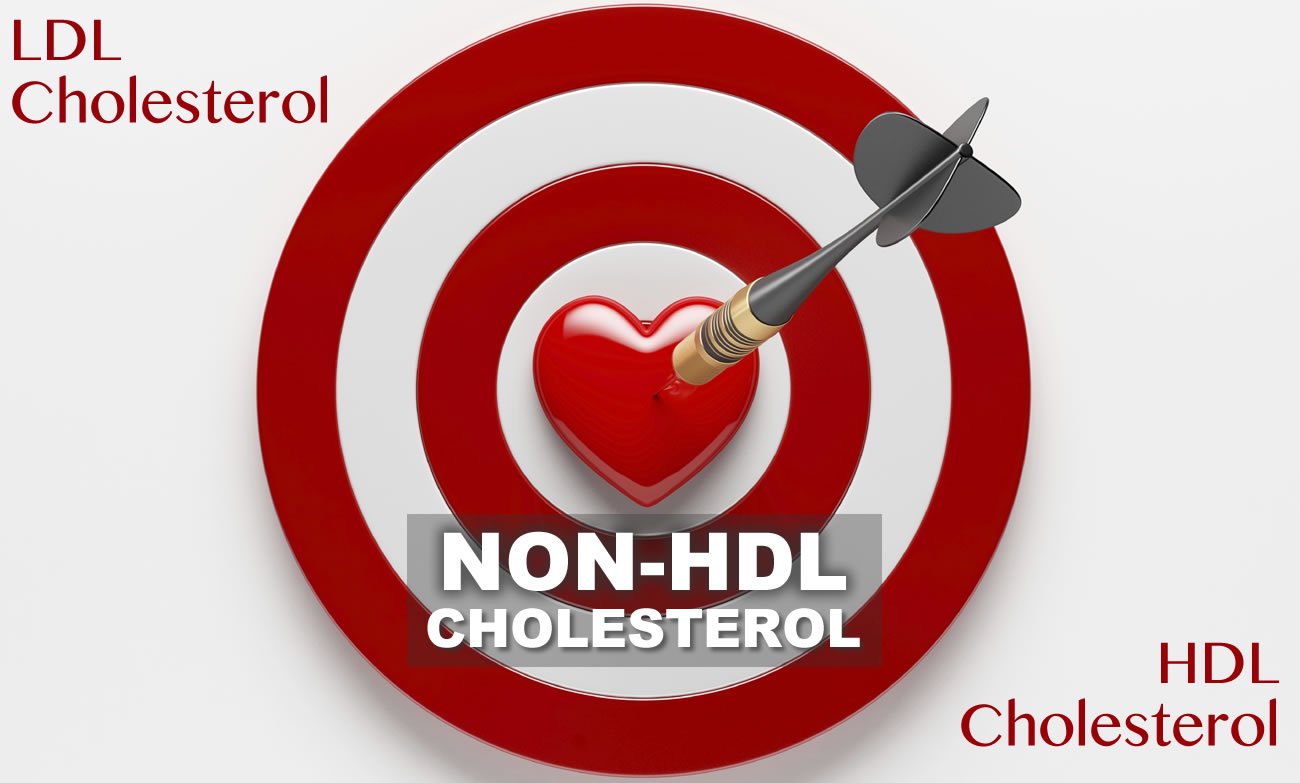Non-HDL Cholesterol Goal | What’s Optimal?
LDL cholesterol is not the only bad thing embedding itself in our artery walls. To get a sense of all our plaque producers, non-HDL cholesterol is the number to look at.

What is non-HDL cholesterol?
Total cholesterol minus HDL cholesterol equals non-HDL cholesterol. So if your total cholesterol is 200 and your HDL cholesterol is 50, your non-HDL cholesterol is 150.
Non-HDL may predict risk of cardiovascular disease better than LDL because non-HDL contains not only LDL but all other particles that are “bad.” Just like LDL, these particles contribute to the build-up of cholesterol-filled plaques in the walls of our arteries.
The excessive formation of plaques is the primary cause of atherosclerosis, or heart disease.
ApoB
All these plaque-producing particles have one thing in common. They are all carried through the blood by a protein called apoB (apolipoprotein B), commonly known as the “bad” protein.
Non-HDL cholesterol is a measure of all these apoB-containing particles. They include LDL as well as IDL (intermediate-density lipoprotein), VLDL (very-low-density lipoprotein) and chylomicrons.
Bottom Line: LDL is still “bad”…
But we now know that LDL is not the only bad thing embedding itself in our artery walls. To get a sense of all our plaque producers, non-HDL cholesterol is the number to look at.
What is an optimal non-HDL cholesterol goal?
For an optimal non-HDL cholesterol goal, one that gives us the best protection against heart attacks and other serious cardiovascular conditions, here is what recent evidence-based medicine tell us:
- The IMPROVE-IT1 trial, which followed 18,144 heart patients for 6 years, reported that non-HDL levels of 77 resulted in improved cardiovascular outcomes, including lower risk of heart attacks and cardiovascular deaths, compared to higher non-HDL levels.
- In the multicenter PRECISE-IVUS Trial2 treating 202 heart patients for 9 to 12 months, those who lowered non-HDL levels to 84 showed greater regression (shrinking) of coronary artery plaque than those with higher levels.
The Pritikin Scientific Advisory Board therefore recommends the following:
Those with clear evidence of coronary artery disease include people who have suffered a heart attack or stroke, or who have undergone surgery to open up or bypass blocked arteries. A non-HDL less than 80 is also recommended for people at high risk of cardiovascular events because they have multiple risk factors, such as diabetes, hypertension, and excess weight.
For those at highest risk of a cardiovascular event, a non-HDL target of 70 might provide even more protection.
Non-HDL cholesterol goal | What’s optimal?
For healthy individuals wanting to prevent the development of cardiovascular disease: Non-HDL less than 100
Always keep in mind that goals are good, but working toward those goals is also very good.
For virtually everyone, any significant improvement in non-HDL cholesterol likely means significant reductions in heart disease risk. For people with severely elevated cholesterol levels, guidelines from the National Cholesterol Education Program have noted that achieving 30% to 40% reductions from baseline are highly beneficial.
Non-HDL levels improve, and rapidly so, among guests at Pritikin. Research3 on 4,587 men and women at Pritikin found that non-HDL levels fell on average 24% within 3 weeks.
Can non-HDL go too low?
Some data indicate that very low levels of non-HDL (below 40), which are largely the result of high-dose statins, may carry some negative side effects. But for most people with coronary artery disease or at high risk, a non-HDL in the 40 to 80 range is likely a safe and effective therapeutic target.
Heart disease | A collection of risk factors
It is also important to remember that lowering one’s risk of cardiovascular disease involves a lot more than simply reducing cholesterol levels.
Nine other key lifestyle-based risk factors are:
- Sedentary living and decreased fitness level
- Smoking
- Hypertension, including pre-hypertension (a resting blood pressure between 120/80 and 139/89)
- Type 2 diabetes, as well as pre-cursors such as insulin resistance, metabolic syndrome, and pre-diabetes (a fasting blood glucose of 100 to 125 or an A1C of 5.7 to 6.4)
- Increased levels of chronic inflammation, including increased high-sensitivity C-reactive protein
- Increased susceptibility for clot formation
- Elevated triglycerides (fasting levels greater than 150)
- Excess fat/obesity, particularly abdominal (belly) fat
- Stress associated with anger and hostility
The more of these nine risk factors you have, the more cholesterol-filled plaques you likely have, and the more inflamed – and damaged – the inner walls of your arteries become.
Improving all risk factors for heart disease
That’s why, when all is said and done, it is vital to shift the question from “What is the optimal non-HDL cholesterol goal?” to “What is the optimal way to improve all modifiable risk factors for heart disease?”
The answer is embracing a healthy lifestyle like the Pritikin Program.
With Pritikin living, taught at the Pritikin Longevity Center, you are not only lowering cholesterol levels like non-HDL and LDL, you are also lowering virtually all lifestyle-based risk factors for cardiovascular disease. This is heart-health care at its very best.
Lower Your Cholesterol at the Pritikin Health Resort
Take life to the next level, and be all that you can be. That’s what a vacation at Pritikin is all about. Live better. Look better. And best of all, feel better.
Learn More
Sources
- 1 New England Journal of Medicine, 2015; 372 (25): 2387.
- 2 Journal of the American College of Cardiology, 2015; 66: 495.
- 3 Archives of Internal Medicine, 1991; 151: 1389.